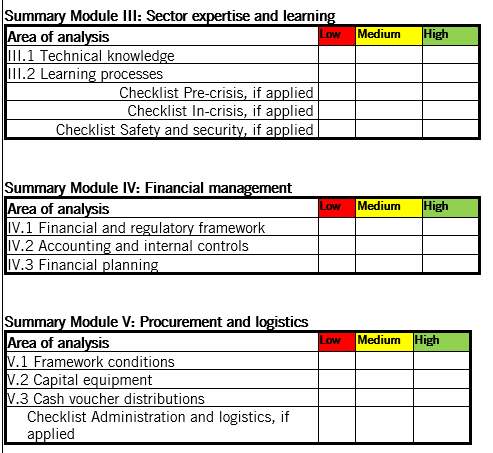This indicator should be collected by projects that focus on capacity strengthening of civil society partners and that run for more than six months. Examples include projects that have a Programming Towards improved Nutrition focus, also Multi Actors Partnership Programs.
Method: Use of the partner assessment tool - Manual 6b (link).
The first round of the assessment should be taken as the baseline. Following this, the civil society organization should be re-assessed either at the end of the project (if the project lasts no more than one year), or annually.
The Welthungerhilfe project that uses this indicator should re-assess the organization fully using Manual 6b again. Alternatively, if time or resource constraints apply, the project can focus only on the low-ranked capacities that the project chose to work on and assess if any progress has been made against these.
Questions: Based on the notes from the assessment tool, please assess the capacity of the organization (low, medium, high) against the following criteria:


How to calculate:
For both the baseline and a given follow-up round, apply the following steps:
- Count the number of capacities that are ranked as low.
- Count the number of capacities that are ranked as medium and multiply by 2.
- Count the number of capacities that are ranked as high and multiply by 3.
- Sum up the three scores, then divide the sum by the number of capacities assessed, in order to obtain the average capacity score.
The indicator value is the number of Civil Society Organizations whose average capacity score is higher during a given follow-up round than during the baseline.
What activities should the indicator be used for?
This indicator should be collected by projects that focus on capacity strengthening of civil society partners and that run for more than six months. Examples include projects that have a Programming Towards improved Nutrition focus, also Multi Actors Partnership Programs.